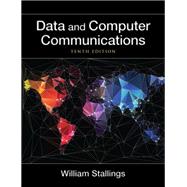Data and Computer Communications, 10e, is a two-time winner of the best Computer Science and Engineering textbook of the year award from the Textbook and Academic Authors Association. It is ideal for one/two-semester courses in Computer Networks, Data Communications, and Communications Networks in CS, CIS, and Electrical Engineering departments. This book is also suitable for Product Development personnel, Programmers, Systems Engineers, Network Designers and others involved in the design of data communications and networking products.
With a focus on the most current technology and a convenient modular format, this best-selling text offers a clear and comprehensive survey of the entire data and computer communications field. Emphasizing both the fundamental principles as well as the critical role of performance in driving protocol and network design, it explores in detail all the critical technical areas in data communications, wide-area networking, local area networking, and protocol design.










